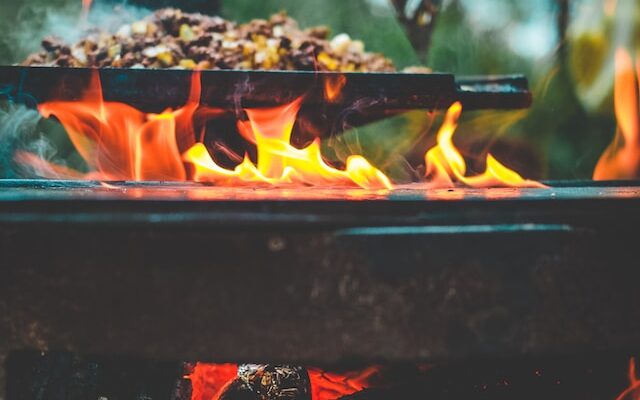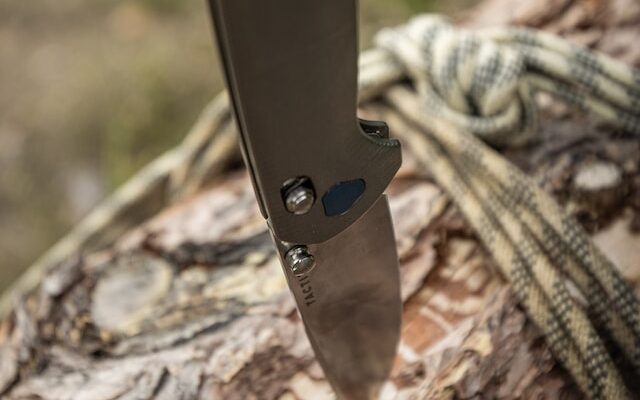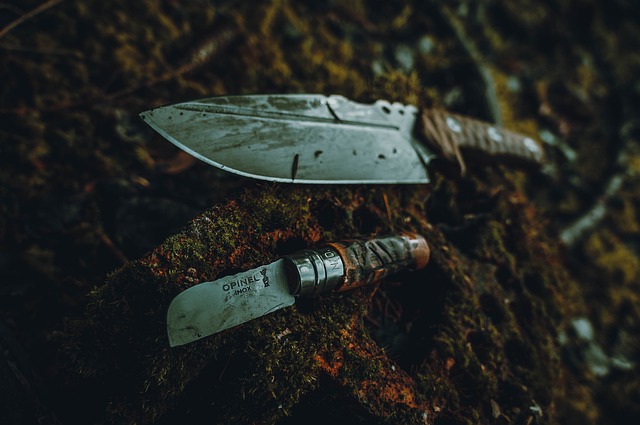Outdoor Cooking Knife: The Adventurer’s Culinary Must-Have
When you’re outdoors, one of the most essential tools is an outdoor cooking knife. It’s use is much more than cooking, from prepping to packing up. That’s why it’s essential to invest in one that’s long lasting and reliable. Let me help you choose which one can be your outdoor companion. First, let’s look back in history when we began using tools for different purposes, specifically cooking.
Historical relationship between humans and knives
Since the dawn of humanity, knives have been a part of everyday life. Think back to our ancestors, the hunter-gatherers. Their survival hinged upon their ability to hunt and process food, and the knife was their tool of choice.
Carving tools from stones, early humans realized the importance of a sharp edge. It allowed them to cut through meat, shape objects, protect themselves, and even create art. As the millennia rolled on, the knife evolved from crude stone to polished metal, but its significance in our lives remained unchanged.
The shift from indoors to outdoors
Over the last few decades, there’s been a pronounced movement towards outdoor recreational activities. This has been driven by a need to reconnect with nature, escape urban confines, and perhaps, recapture some essence of our more primal selves.
This shift means more people are cooking outdoors than ever before. But unlike the controlled environment of our kitchens, the outdoors presents a different set of challenges: unpredictable weather, varied terrains, and the absence of modern amenities. This is where the cooking knife highlights its benefits.
An outdoor cooking knife is versatile. Beyond just preparing food, it assists in tasks like setting up camp, creating kindling for fires, or even emergency situations where a sharp tool is essential. Indoors, you might have a range of utensils and gadgets to aid you, but outdoors, the cooking knife often becomes the jack-of-all-trades. Its versatility, combined with the sheer necessity of food preparation in the wild, makes it an indispensable tool for every outdoor enthusiast.

Things to Consider When Buying an Outdoor Cooking Knife
Basic knives can do the job for our outdoor activities, but an outdoor cooking knife has features that set it apart from our basic kitchen knives. It has functionalities that meet our needs when venturing in the great outdoors.
Blade material and durability
The blade is, undoubtedly, the heart of any knife. Its material determines not just how sharp it can get, but also how long it stays that way, and how it stands up to the rigors of outdoor use.
Stainless steel vs. carbon steel
Stainless Steel: Known for its resistance to rust and staining, stainless steel is a popular choice for outdoor enthusiasts, especially those who might be cooking near water or in damp conditions. It typically requires less maintenance and is more forgiving if accidentally left wet overnight. However, it might lose its edge quicker than carbon steel.
Carbon Steel: Revered for its ability to maintain a sharp edge for longer periods, carbon steel has its loyalists. It’s also generally easier to sharpen. The downside? It’s prone to rust if not adequately cared for. If you opt for carbon steel, ensure you clean and dry it after every use.
Knife handle and its importance
A blade is only as good as its handle. It’s the point of interaction between you and the tool. A poorly designed handle can make even the sharpest blade ineffective.
Grip, material, and ergonomics
Grip: A good grip can make all the difference. Look for handles with texturing or patterns that enhance grip. Rubber or contoured handles can also improve traction.
Material: From classic wood and durable rubber to modern composites and even bone, handle materials can widely vary. While wood has a timeless appeal, materials like G10 or Micarta offer robustness and water resistance.
Ergonomics: A handle should feel like an extension of your hand. It should be comfortable and not cause strain even after prolonged use. An ergonomic design ensures that the knife feels balanced, reduces hand fatigue, and provides optimal leverage.
Portability and size
While it might be tempting to go for a large, machete-like knife, practicality is more important. For outdoor cooking, you typically don’t need a very long blade. A medium-sized knife, about 4 to 6 inches, often suffices for most tasks from slicing to dicing.
An outdoor cooking knife should be easy to carry, whether in a sheath, attached to your belt, or stowed in your backpack. Some knives come with foldable designs or feature holes for attaching to carabiners, adding to their portability.

Maintaining Your Outdoor Cooking Knife
Investing in an outdoor cooking knife is just the first step. To ensure that your knife stands the test of time and remains a reliable companion, proper maintenance is necessary. From the way you clean it after a campfire cookout to how you store it when not in use, each step contributes to its longevity and performance.
Cleaning and storage
Outdoor cooking often exposes your knife to various elements: from the acidic juices of fruits and meats to the minerals in water and the dirt of the wilderness. Here’s how to keep it in tip-top shape:
Cleaning: After every use, especially if you’ve cut acidic or sticky foods, it’s essential to clean your knife promptly. Use warm water and mild soap to gently clean the blade and handle. Avoid abrasive scrubbers that might scratch the blade’s surface. If there are stubborn residues, let the knife soak for a few minutes before cleaning.
Drying: Once cleaned, thoroughly dry the knife using a soft cloth. It’s vital, especially for carbon steel blades, to prevent rusting. Ensure that the hinge area (for folding knives) is dry to avoid any accumulation of moisture that might cause corrosion.
Storage: Always store your knife in a dry place, away from moisture. If it comes with a sheath, ensure the sheath is clean and dry before storing the knife. For folding knives, keep them folded when not in use to protect the blade. Avoid throwing the knife haphazardly into a drawer with other tools; not only can this dull the blade, but it can also lead to unintentional injuries.
Honing and sharpening
A sharp knife isn’t just effective—it’s also safer. A dull blade requires more force to cut, increasing the risk of slipping. Here’s how to keep that edge razor-sharp:
Honing: This is the process of straightening the blade’s edge without removing significant amounts of metal. Using a honing rod, often made of ceramic or steel, run the blade’s edge along the rod at the correct angle (usually around 20 degrees) to realign any microscopic dents or bends. It’s a good practice to hone your knife regularly, even after every use.
Sharpening: Over time, honing might not be enough, and you’ll need to sharpen the blade. Using a sharpening stone or a knife sharpener, you’ll gently grind away a tiny amount of metal to create a new, sharp edge. The angle is crucial here too; maintain a consistent angle for best results. Depending on usage, you might need to sharpen your knife every few months.

Safety Precautions for Outdoor Knife Use
Ensuring safety, especially when using tools like the outdoor cooking knife is non-negotiable. While these knives are invaluable allies in the wilderness, they can also pose risks if not handled correctly. Here’s a guide on safe usage, handling, and navigating varied weather conditions.
Proper handling and storage
Just like in a kitchen, the outdoor setting requires due diligence when working with sharp tools.
Awareness: Always be conscious of your surroundings when using the knife. Be aware of anyone standing close by, especially children, and ensure you have enough space to operate without inadvertently causing harm.
Secure Grip: Wet or sweaty hands can easily lead to accidents. Before you use your knife, ensure your hands are dry. Handles with good grip designs can also be a significant asset in these situations.
Open and Close with Care: If you’re using a folding knife, open and close it with deliberate care. Ensure your fingers are not in the blade’s path. Using a two-hand method—holding the base with one hand while opening or closing with the other—can reduce the risk of injuries.
Safe Storage: When not in use, store the knife safely. If it’s a folding knife, keep it folded. For fixed-blade knives, using a sheath is necessary. Never leave a naked blade exposed in your camp or resting on surfaces where someone might inadvertently grab the sharp edge.
Usage in varying weather conditions
The outdoors doesn’t offer the controlled environment of our homes. Weather can change rapidly, and with these changes come different challenges in knife safety.
Wet Conditions: Rain or morning dew can make everything slippery, including your knife handle. If you must use your knife during wet conditions, ensure your grip is secure. Wipe the handle dry and remember to dry your knife thoroughly after use to prevent rusting.
Cold Weather: Cold can numb your fingers, reducing dexterity and grip strength. If you’re camping in cold conditions, warm your hands before using the knife. Cold can also make some materials brittle; be gentle to avoid chipping the blade or damaging the handle.
Wind: Strong winds can affect your precision. If you’re cutting something, ensure it’s secured so that the wind doesn’t blow it away, potentially causing you to make a wrong move with the knife.
My Personal Recommendations
Over the years, I’ve had the pleasure of trying a plethora of outdoor cooking knives. From trusty companions that have been with me through thick and thin to those that left me wanting more, my experiences have given me a profound appreciation for quality and functionality. Below, I’ve curated a list of my top three outdoor cooking knives and the reasons they’ve captured my heart.
My Top Three Outdoor Cooking Knives
Morakniv Companion Sandvik Stainless Steel Fixed-Blade Knife
A true stalwart in the world of outdoor knives, the Morakniv Companion has earned its reputation. With its durable stainless steel blade and ergonomic rubber handle, this Swedish marvel is a testament to simplicity meeting functionality.
Benchmade – Buschcrafter 162 Outdoor Knife
This knife feels like a luxurious extension of one’s hand. Designed for the rigors of bushcrafting tasks, the Benchmade Bushcrafter boasts a high-quality S30V stainless steel blade, with a durable G10 handle that can withstand harsh outdoor conditions.
Gerber Gear Strongarm – Fixed Blade Tactical Knife
Gerber has a long-standing reputation in the knife world, and the StrongArm is a shining example of their commitment to quality. With a full tang design and a diamond-texture rubber handle, this knife ensures you have a solid grip even in the most challenging conditions. Its blade is made of high carbon stainless steel, offering a beautiful balance between sharpness and durability.
Why I love them
Durability: All three of these knives are built to last. Whether it’s the high carbon steel of the Gerber StrongArm, the stainless steel marvel of Morakniv, or the S30V blade of the Bushcrafter, they’re all designed to resist wear and tear, serving as lifelong companions.
Ergonomics: A knife can have the sharpest blade in the world, but if it’s uncomfortable to hold, its utility diminishes. The ergonomically designed handles of these knives, be it the rubber grip of Morakniv, the G10 handle of the Bushcrafter, or the textured grip of the StrongArm, ensure prolonged use without fatigue.
Versatility: These knives are not just about cooking. Their design ensures they’re versatile tools capable of handling multiple outdoor tasks, from preparing firewood to crafting makeshift tools.
Reputation: The brands behind these knives—Morakniv, Benchmade, and Gerber—are renowned for their commitment to quality. A glance at any knife forum or review site will reveal glowing testimonials from outdoor enthusiasts globally, attesting to their excellence.
Conclusion
An outdoor cooking knife is an indispensable tool in the modern wilderness. Through centuries, as we’ve migrated from our indoor hearths to explore the vast beauty of the outdoors, the significance of these knives has only magnified. Choosing an outdoor cooking knife depends on a variety of factors: from blade materials to ergonomic design. Brands like Morakniv, Benchmade, and Gerber, among others, have showcased that knives have come a long way from being tools carved from stone.
To sum up, remember to choose wisely, treat it with care, and let every slice and dice be a tribute to the times when our ancestors used this tool first and have been a companion since.
FAQs
1. Why is an outdoor cooking knife essential for adventurers?
An outdoor cooking knife is a versatile tool that can assist in various tasks, from preparing kindling for a fire to emergency situations, such as crafting a makeshift tool. Its durability and design are tailored to withstand the unpredictability of outdoor environments, making it an indispensable companion for adventurers.
2. How is an outdoor cooking knife different from a regular kitchen knife?
While both can be used for cutting and prepping food, outdoor cooking knives are designed with durability in mind to handle the rough conditions of the outdoors. They often feature more robust materials, ergonomic handles for a firmer grip, and sometimes additional functionalities like serrations or gut hooks. Additionally, they’re built to resist elements like moisture, which can cause rust or degrade the knife over time.
3. What should I look for in terms of blade material?
When selecting an outdoor cooking knife, the two most common blade materials are stainless steel and carbon steel. Stainless steel is corrosion-resistant, making it ideal for wet conditions, while carbon steel, although more susceptible to rust, often provides a sharper edge and is easier to hone.
4. How often should I sharpen my outdoor cooking knife?
The frequency of sharpening depends on the usage. If you use your knife regularly during trips, it’s a good practice to hone it after every use to maintain the edge and sharpen it properly every few trips. However, always ensure you’re using the right sharpening technique to avoid damaging the blade.
5. Are folding knives good for outdoor cooking, or should I opt for a fixed blade?
Both have their merits. Folding knives are compact and great for portability, making them suitable for light to medium tasks. Fixed blades, on the other hand, are generally sturdier and can handle more rigorous tasks. If you’re heavily into outdoor cooking and need a knife for various chores, a fixed blade might be more beneficial. However, if you’re looking for something compact for occasional use, a folding knife will serve you well.







Comments are closed.